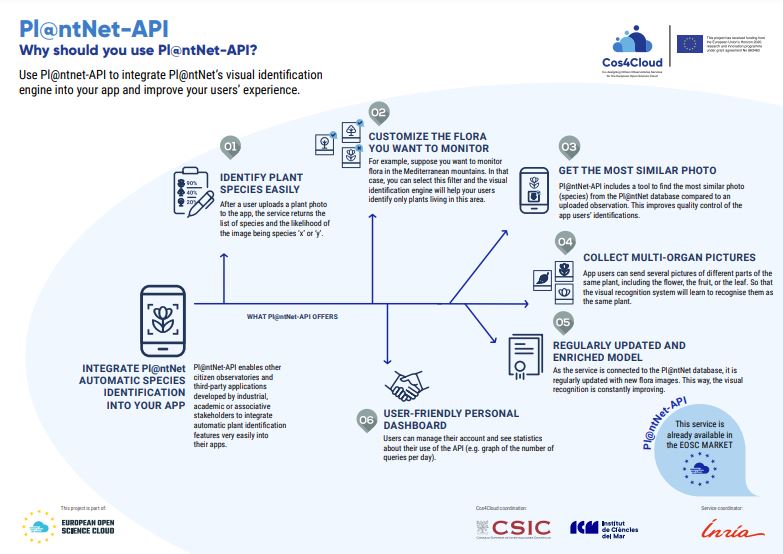Use Pl@ntnet-API to integrate Pl@ntNet’s visual identification engine into your app and improve your users’ experience.
Service description:
This service has developed an Application Programming Interface (API) allowing users to query the Pl@ntNet identification engine. This service is available to developers, researchers and other citizen science observatories interested in plant biodiversity
Pl@ntNet-API enables other citizen observatories and third-party applications developed by industrial, academic or associative stakeholders to integrate automatic plant identification features very easily into their apps. This service is regularly updated and enriched. Because it is connected to the Pl@ntNet database, it is regularly updated with new flora images. This means the visual recognition is constantly improving.
Additionally, Pl@ntNet-API incorporates automated rejection of inappropriate content. This means that any pictures of non-plant entities are filtered out and no results are returned. Specifically, inappropriate content such as faces or pornographic content receives special attention for recognition.
The service also monitors the quality of service provided based on several criteria (status, response time, scalability, etc.) and includes an alert system that allows developers to react quickly.
Yes, you can access it with an API key: To use the service, users must set up an account (validating their email) and are assigned a token. Moreover, access can also be granted using Authenix access_token issued by an official app, like Cos4Bio.
Development & how it works:
Example: A citizen observatory developing a new app related to biodiversity will be able to integrate an automatic plant identification feature without managing it itself.
The website my.plantnet.org provides rich documentation of the service as well as a dashboard allowing users to track their use of the service.
Note that Pl@ntNet’s infrastructure and data-management software are highly scalable. So, if you are a developer of downstream applications, you don’t have to manage the workload yourself!
Innovation for citizen observatories:
If you integrate Pl@ntNet-API into your app, your users will be able to:
- A citizen observatory developing a new app related to biodiversity will be able to integrate an automatic plant-identification feature without managing it itself.
- Contribute to the platform by uploading your own sets of plant observations.
- Identify plant species easily: When a user uploads a plant photo to the app, the service returns the list of species and the likelihood of the image being species ‘x’ or ‘y’.
- Get the most similar photo: Pl@ntnet-API includes a tool to find the most similar photo (species) from the Pl@ntNet database compared to an uploaded observation. This improves quality control of the app users’ identifications.
- Enhanced recognition with multiple photos of different organs: App users can send several pictures of different parts of the same plant, including the flower, the fruit, or the leaf. So that the visual recognition system will learn to recognise them as the same plant.
- User-friendly personal dashboard: Users can manage their account and see statistics about their use of the API (e.g. graph of the number of queries per day).
- As app developers, you will also be able to customize the flora you want your users to monitor. For example, suppose you want to monitor flora in the Mediterranean mountains. In that case, you can select this filter and the visual identification engine will help your users identify only plants living in this area.
Questions & answers
- Who is this service meant for? Do I need a technical background?
Developers with some experience in web technologies.
- Will this service be updated?
Yes, the identification quality is regularly improved and the number of recognized species regularly increased: the more observations Pl@ntNet app receives, the better the visual plant-recognition system works.
- Is it secure to access the API?
- Are Pl@ntNet-API’s infrastructure and data-management software scalable?
Yes, they are highly scalable. This way, developers of downstream applications do not have to manage the workload themselves.
EOSC Marketplace:
Guidelines and documentation to use Pl@ntNet-API:
Related news:
Coordinator:
Keywords:
Pl@ntNet, artificial intelligence, plant species, automatic plant identification




















